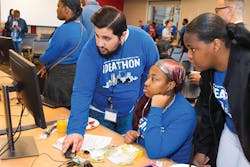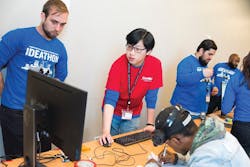Professionals Mentor Tomorrow's Workforce
With the increasing threats of climate change and cybersecurity, electric utility engineers today need to protect the existing grid while looking to the future. To transform the power system to become greener, more efficient and more resilient for generations to come, the engineering team of the future needs to be diverse in talent, experience and learning styles. Likewise, the utility of the future needs to hear the diverse needs of the community as it helps established engineers to teach and future engineers to learn.
Today, with exciting technological developments and demand for cleaner energy, Commonwealth Edison Co. (ComEd) is innovating with a sense of urgency while working to inspire a future generation of engineers with the skills to meet the challenges of tomorrow. However, there is a lack of students graduating into the workforce, especially in science, technology, engineering and math (STEM) fields.
According to the U.S. Bureau of Labor Statistics, thousands of STEM jobs are vacant across the U.S., with a noticeable gap in representation from women, minorities and those from underserved communities. Meanwhile, STEM-related careers are expected to grow by 10.8% over the next 10 years. A recent study by the National Institute for Early Education Research showed early exposure to STEM skills is an enormously impactful indicator for future success in these disciplines. Yet, too many students throughout ComEd’s service territory (and across the U.S., in general) were not getting this level of educational opportunity and career training. Therefore, the utility stepped up by creating STEM education programs to help develop the engineers of the future.
Mentoring Students
The U.S. Bureau of Labor Statistics reports only 24% of those in STEM careers are women, 7% are Hispanic and 9% are African American. ComEd has developed STEM programs to lessen these gaps by targeting communities in its service territory that are most in need of supplemental STEM education but often overlooked.
Mentorship is the foundation of ComEd’s STEM education strategy, and some of the engineers who are mentors come from the same communities as the students who continue to be overlooked. Those engineers can bridge the gap between skill and application in a relatable way. The utility engineers who have built and maintained the grid are the exact people who should be teaching how to transform it.
The impact of these programs is not just the lessons students learn; it is being able to visualize what a professional engineer looks like and does. The connections students form with these engineers help them to identify and navigate the right professional opportunities in their career.
The curricula of ComEd’s STEM education programs emphasize technical skills along with teamwork, leadership, communication and presentation skills. The engineers of the future who participate in these programs are being primed to bridge the gap between technological advancement and effective communication. They do not just know how to execute and solve problems; they can explain what they are developing and why, with the ability to lead others to do the same. Teaching these concepts and applications to the next generation also enables today’s utility engineers to refine and practice their own communication skills.
Create-A-Spark
In 2019, ComEd’s HFS Chicago Scholars’ Create-A-Spark program expanded to include 100 total freshmen and sophomore high school students engaging in a presentation of ideas and subsequent competition. Winning criteria for the student prototypes in the competition included the potential to deliver community benefits related to health, safety, sustainability, connectedness, mobility, efficiency and education.
Students who participate in the Create-A-Spark program come from economically disadvantaged Chicago, Illinois, U.S., families and excel academically. HFS reports that more than 90% of these scholars make the honor roll at top Chicago high schools.
In 2019, freshman team “BACK” was awarded US$2000 for an innovative technology concept called Smart Pathways. Smart Pathways was developed to light pathways in an energy-efficient way by using motion sensors and light-dimming capabilities. The Smart Pathways prototype also included safety features such as movement tracking through its light sensors.
This concept reflected a project ComEd smart grid engineers developed as part of the utility’s Community of the Future initiative, the ARIS off-grid lighting project. In 2019, ComEd’s team developed and deployed seven solar-, wind- and battery-powered lighting units in the Bronzeville neighborhood of Chicago. Seeing ComEd engineers influencing students in real and tangible situations elicits excitement for what these students might do in the future.
Power Challenge
ComEd’s inaugural Power Challenge program for sophomore, junior and senior high school students, cohosted by the IEEE Power & Energy Society (IEEE PES), is engaging more than 125 scholars from across the utility’s territory to develop energy-related projects for a competition and poster presentation at the IEEE PES T&D Conference and Exposition in October 2020 in Chicago.
This opportunity involves research-intensive innovation for students interested in developing skills in the areas of distribution, transmission, generation and renewable energy. To kick off the initiative, ComEd utility engineers gave presentations to the students on each topic and provided guidance throughout the project selection. More than 50 engineers are mentoring student teams directly throughout the life span of the projects, offering students a chance to develop STEM skills by solving real-world problems alongside professionals in the field.
Students recently submitted abstract proposals to their mentors and are generating a range of projects directly applicable today in electric utility operations. One group is developing a hydroelectric power pump powered by solar energy. Another group, interested in the dangers to wildlife caused by electrocution, is researching improved power distribution methods specifically to avoid harm to wild animals. A more experimentally focused group proposed 3-D printing an electric pole model to test pole tilt and crossarm sensors with the goal of improving pole safety and maintenance.
Mercy Home
ComEd also instituted two summer through fall programs in 2019 with the Mercy Home for Boys and Girls, a nonprofit organization in Chicago that offers safety, residency and education to children in need.
“Our mentors and coaches have the power to inspire us in profound ways, sharing stories and tools that are unique yet relatable. Mentorship creates enriched environments, and the ability to engage mentally and emotionally with students who have differing perspectives is a blessing. I come to work every day to help power lives, and the opportunity to share the art of connecting STEM to practical applications is tremendously gratifying”, said ComEd engineer Sainab “Taiwo” Ninalowo.
Students at the Mercy Home for Girls learned to work with circuit boards and build projects, such as a working FM/AM radio. They also got an opportunity to hear from female ComEd engineers about their life stories, which empowered the girls to share their own life experiences. Similarly, the Mercy Home for Boys students were introduced to ComEd engineers and professionals who shared their life experiences and academic paths to model the value of rising to meet challenges. They also had an opportunity to see ComEd linemen and electricians in action.
Future Engineers
These ComEd programs serve as an opportunity to spark an energy and sustainability mindset in students, encouraging the younger generations to contribute to their future by solving real-world challenges. A significant and ever-present theme throughout each of the programs is ensuring students understand the effects of climate change and are well-versed in strategies and habits they can use now to decrease their carbon footprint and keep climate change issues in mind when developing engineering projects.
A STEM-prepared population well-versed in climate change issues will support maintaining and developing innovations to solve current and future energy issues. This valuable exposure works to spark STEM interest in young people and open them up to career possibilities they might not have considered otherwise. What is more, as students learn to meet challenges that arise in their own lives, they will be better prepared to meet external challenges, solving problems on a larger scale.
For students who participate in ComEd’s STEM education programs, mentorship is a key component. The engineers teach STEM skills, expose students to the latest technology and help them to cultivate a problem-solving mindset. It is imperative not just to solve today’s problems but also to mobilize a plan to overcome the energy problems of the future. The best way to plan for the future is to invest in the children who will build it. ComEd’s team believes this and will continue helping to develop the engineers of the future.
For more information:
ARIS Renewable Energy LLC | https://arisrenewableenergy.business.site
About the Author
Aleksi Paaso
ALEKSI PAASO ([email protected]) is director of distribution planning, smart grid and innovation at ComEd, where he is responsible for distribution planning activities, distributed energy resource (DER), and smart grid strategy and project execution. He is a senior member of the IEEE and vice chair of the IEEE Power & Energy Society’s (PES) Industry Technical Support – Leadership Committee (ITS-LC). He holds a Ph.D. in electrical engineering from the University of Kentucky.
Daniel Kushner
Daniel Kushner is Director of Resiliency Strategy at LUMA Energy. He holds a bachelor's degree in history from Johns Hopkins University and a PhD in political science from Brown University.
William Hanigan
William Hanigan is manager of Smart Grid Programming at Commonwealth Edison (ComEd), the largest electric utility in the state of Illinois. Hanigan leads planning, development, and execution of ComEd STEM Programs, creating the vision for how to prepare engineers of tomorrow for present and future challenges. Hanigan formerly served as director of operations at HFS Chicago Scholars, was an employee of Chicago Public Schools and holds a master’s degree in Special Education and Teaching from the University of Illinois at Urbana-Champaign.



